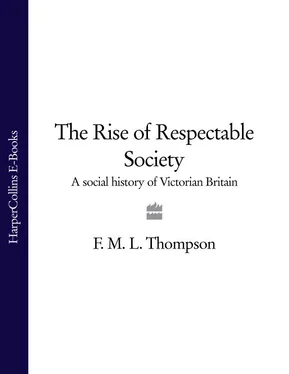Viewed in this light the quintessentially novel feature of Victorian urbanization was the growth of the large-town population outside London from just over one million in 1831 to nearly nine million in 1901, from less than one tenth to about a quarter of the British people. It would be wrong to infer from this that London was outpaced or displaced by the large provincial cities, for if the continuous built-up area of Greater London is taken as the appropriate demographic and social unit for measurement, it increased its share of total population from 11.5 to 17.8 per cent in this period, thus decisively resuming its relative growth which had virtually halted in the eighteenth century. Equally it would be simplistic and misleading to leap from the unprecedented growth of extra-metropolitan large towns to the conclusion that all the exciting action of Victorian social history took place in that arena. Nevertheless that growth, and its timing, are crucial in placing the time-scale of the emergence of a modern urban and industrial society in Britain: however far the British economy may have travelled by 1830 beyond the point of no return on the path towards industrialization, Britain was still far from possessing that kind of society.
Its emergence was a Victorian affair. It was not a question of the Victorians improving, reforming, institutionalizing, and more or less cleaning up a rough and raw society which they took over from the preceding half century of headlong economic change; it was rather a matter of their fashioning the elements of a new society in step with the appearance of its material and human components. This is not to deny that there were raw, indigestible, and unassimilated new elements already present in society as a consequence of previous urban and industrial growth. Manchester was already acquiring its reputation as the shock city of the Industrial Revolution, and Leeds was not far behind; but this was precisely because such places were so unusual and unfamiliar. More traditional environments and communities remained so much more typical, even if jobs and workplaces might have altered radically, that society as a whole had tolerated such exceptions without being transformed. Transformation was a long-drawn-out process, longer drawn out than the coming of machines and power and the transformation of the means of production. The making of the working class, once thought to have been accomplished by 1830, is now placed firmly in the 1890s; and many of the features of modern society, trivial and profound, from smaller families to bacon and eggs, from production-line working to fish and chips, or from class politics to branded foods, only made a strong appearance in the closing years of the nineteenth century. Family and neighbourhood ties, upbringing, inherited cultures, and group loyalties proved more persistent and resilient than technologies, which might change almost overnight. These social forces were sufficiently powerful to smooth the impact of new working and living conditions, and to ease the passage towards large-town society without disastrous dislocation. A fruitful tension, and accommodation, between social continuity and conservatism, and economic innovation and discontinuity, was an underlying theme of the Victorian period.
The economy and society of the early 1830s, then, was not grossly distorted by the political mirror of the first Reform Act. Factory industry and urban concentrations were present, but not in sufficient proportion to eclipse the familiar world of farm and workshop, labourer, craftsman, and trader, village and small town, and it made reasonable sense to leave authority substantially in the hands which had held it for generations, those of landowners, clergy, lawyers, and greater merchants. The economic foundations of this social and political order were changing rapidly. The most momentous end-product of those changes was the growth of large towns, and it used to be assumed that industrialization and urbanization were synonymous. The distinction between the two processes, however, is critical to understanding the way in which people at all levels of society contrived to weather the shocks and stresses of revolutionary changes in working conditions or living arrangements without society itself experiencing the catastrophic disintegration or outright social revolution which were widely thought, especially in the 1840s, and not only by alarmists, to be inescapable and imminent.
Much more is involved than the observation that not all industry was urban and that not all the fastest growing, or largest, towns were industrial. Although this was a most important point about the early 1830s, when Brighton, emphatically a pleasure rather than a business let alone an industrial town, had been the fastest growing town of the previous decade, and when an important group of water-powered cotton mills were in semi-rural locations, it was of diminishing relevance over the rest of the century. The general tendency was for the mechanization of a broadening range of industrial activities, the adoption of steam power, and a gravitation towards coalfield sites; while all the larger towns supported some manufacturing industries, even if these might in some cases be geared only to their own internal markets. What continued to be important in the shaping of social structures was the diversity of developments within and between industries, in timing, technologies, and organization, and the variety of different occupations and activities forming the economic base of towns.
Industrialization, even considered in the restrictive and potentially misleading sense as something that happened simply to manufacturing industry rather than to all sectors of the economy, was far from being a one-way procession into the factory. Mechanization of one sector or process in an industry, and its move into the factory, could well generate increased demand for handwork and outwork in other sectors. The classic example was in the cotton industry, where from the later eighteenth century the rise of the spinning mills had led to an enormous expansion in the number of handloom weavers, most of them outworkers (a minority were pseudo-factory workers, working in large weaving sheds for a single employer), and many of them rural workers with dual employments in farming. In cotton that expansion was over by the mid-1820s, and the decline in the number of handloom weavers as weaving moved swiftly into the mills in the 1830s and 1840s was little short of catastrophic in material hardship and social dislocation. In spite of the evident triumph of the powerloom, however, there were still nearly 50,000 cotton handloom weavers left in 1850, many of them in extreme destitution at the lowest paid and coarsest end of the industry, but some of them working upmarket on fancy designs in short runs which were still beyond the technical capacity, or economics, of power weaving. A few lingered into the 1860s, but by then the surviving handloom weaver in cottons was no more than a curiosity. The worsted industry followed much the same pattern as cotton, although barely one fifth as large in terms of total employment, and by the early 1830s worsted spinning was almost entirely a factory occupation; the key preparatory process of combing, however, remained a manual operation, and the woolcombers were among the cream of skilled workers until combing machinery undermined their scarcity and status extremely rapidly from the mid-1840s. Worsted weaving, indeed, became a factory industry even more rapidly and conclusively than cotton: until the mid-1830s there were virtually no powerlooms in worsteds, and by the mid-1850s handloom weavers had all but vanished. In the process the industry, spinning and weaving branches alike, achieved a far more complete geographical concentration than the cotton industry which had an important secondary base in Lanarkshire centred on Paisley as well as its Lancashire-Cheshire heartland. Worsted workers, by the 1850s, were almost all to be found in the West Riding, strongly localized in the Bradford area, and this sharp focus of a particular kind of factory experience was not without social significance.
Читать дальше












